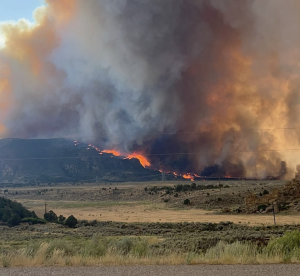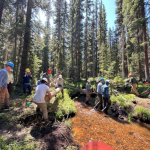Writers on the range: Coal gets a boost as renewables are gutted
Writers on the Range

Courtesy Photo
A few years back, my friend Norm told me that when he was growing up in northern New Mexico in the 1950s and early ’60s, his family often drove up to the La Plata Mountains in southwestern Colorado. From there he could see all the way to the Sandia Mountains outside Albuquerque, some 200 miles away.
His statement saddened me, since in all the time I spent on Four Corners high points, a persistent haze always limited my visibility to maybe 50 or 60 miles, blurring Shiprock’s sharp spires into a fuzzy silhouette. That’s because a fleet of massive coal-fired power plants in the region churned out haze-producing pollutants, harming humans and the ecology and blotting out vistas from the San Juans to the Sandias. It seemed as if I’d never get a view as clear as Norm’s.
But over the last decade, the failing economics of coal shuttered those power plants. That means the air on the Colorado Plateau—when not sullied by the ever-lengthening wildfire season—has become cleaner as the coal industry faded away.
The shuttered plants include Mojave, Navajo, Nucla, Escalante, San Juan and, most recently, Cholla. The closures certainly sharpened the view of folks all over the region. But more importantly, they kept tens of millions of tons of greenhouse gases out of the atmosphere and oodles of harmful pollutants (arsenic, mercury, sulfur dioxide and soot) out of the lungs of nearby residents, many of them on the Navajo Nation.
Yet in defiance of the free market that has boosted renewables, the Trump administration is acting to undo those positive changes and make the air dirty again by throwing multiple lifelines to the flagging coal industry.
It has eviscerated environmental protections limiting mercury and other toxic air emissions, ended Obama-and Biden-era freezes on new federal coal leases, and rescinded limits on carbon dioxide emissions. The administration has also blocked utilities from shutting down plants that are old, dirty and more costly than other power sources.
Trump purports to do this in the name of “unleashing” coal from regulatory constraints so it can be mined and burned to achieve American “energy dominance.” Yet it’s unlikely that unleashing the industry will reverse its decline.
It’s true that delaying implementation of the mercury rule will enable the Colstrip coal plant in Montana—one of the nation’s dirtiest facilities—to continue operating without expensive new pollution control equipment. Generally, though, utilities such as Xcel Energy, Intermountain Power Agency and Tri-State Generation & Transmission are moving forward with plans to retire their coal plants, namely because the aging facilities are dirty, inefficient, inflexible and, most of all, no longer profitable. They just can’t compete with natural gas, solar, wind, and other, cleaner energy sources.
When signing one of his fossil-fuel-friendly orders, Trump said he would “save” the Cholla coal plant near Holbrook, Arizona, from destruction, adding, “We’re going to have that plant opening and burning the clean coal, beautiful clean coal, in a very short period of time.”
But its operator, Arizona Public Service, said it had already procured cleaner, cheaper generation for the plant, and had no desire to keep burning coal at Cholla. There was no save needed.
If Trump were truly interested in energy dominance and abundance, he would have supported the fastest-growing energy sources—wind and solar power. Instead, his administration is doing all it can to stifle them, from eliminating production tax credits for renewable energy in his “big, beautiful” budget bill, to slowing down permits for clean energy developments on public lands. Both utility-scale and rooftop solar will be affected, boosting the prospects of oil and gas, coal and nuclear.
U.S. Energy Secretary Chris Wright, in an Economist column, revealed the philosophy behind the administration’s fossil-fuel fetishization. He wrote that climate change is “not an existential crisis,” merely a “byproduct of progress.” He said he was willing to take the “modest negative trade-off” of climate change—along, presumably, with ever more devastating heat waves, wildfires and floods—”for this legacy of human advancement.”
He is probably correct in saying that climate change and the sullied air over the Colorado Plateau are byproducts of so-called progress. But they are also nasty, deadly and avoidable. Ultimately, going backward toward coal will not only wreck progress, but perhaps life on earth as we know it.
Jonathan Thompson is a contributor to Writers on the Range, writersontherange.org, an independent nonprofit dedicated to spurring lively conversation about the West. He has long covered the West’s natural resources.

Support Local Journalism

Support Local Journalism
Readers around Craig and Moffat County make the Craig Press’ work possible. Your financial contribution supports our efforts to deliver quality, locally relevant journalism.
Now more than ever, your support is critical to help us keep our community informed about the evolving coronavirus pandemic and the impact it is having locally. Every contribution, however large or small, will make a difference.
Each donation will be used exclusively for the development and creation of increased news coverage.





